Movie WIT (2001): Analyzing Communication Strategies in Nursing Care
VerifiedAdded on 2022/09/02
|8
|1900
|11
Essay
AI Summary
This essay analyzes effective and ineffective communication in nursing, drawing insights from the movie WIT (2001). The essay is divided into two parts, the first part discusses the condition based on the movies perspective, while the second section contains the author's reflection based on the skill gaps, knowledge and plans for the improvement of the effectiveness of communication required in providing nursing care to the patients. The first part discusses the portrayal of Vivian Bearing, a stage IV ovarian cancer patient, and the communication challenges she faces with her medical team, particularly regarding insensitive inquiries about her feelings. It contrasts this with the effective communication demonstrated by Nurse Susie, who establishes a therapeutic relationship through empathy and genuine interaction. The second part reflects on the lessons learned from the movie, emphasizing the importance of understanding patients' feelings through deeper engagement rather than routine questions, advocating for close-ended questions to encourage more meaningful responses, and highlighting the value of maintaining eye contact to build trust and improve patient care, this document is available on Desklib, a platform providing study tools for students.
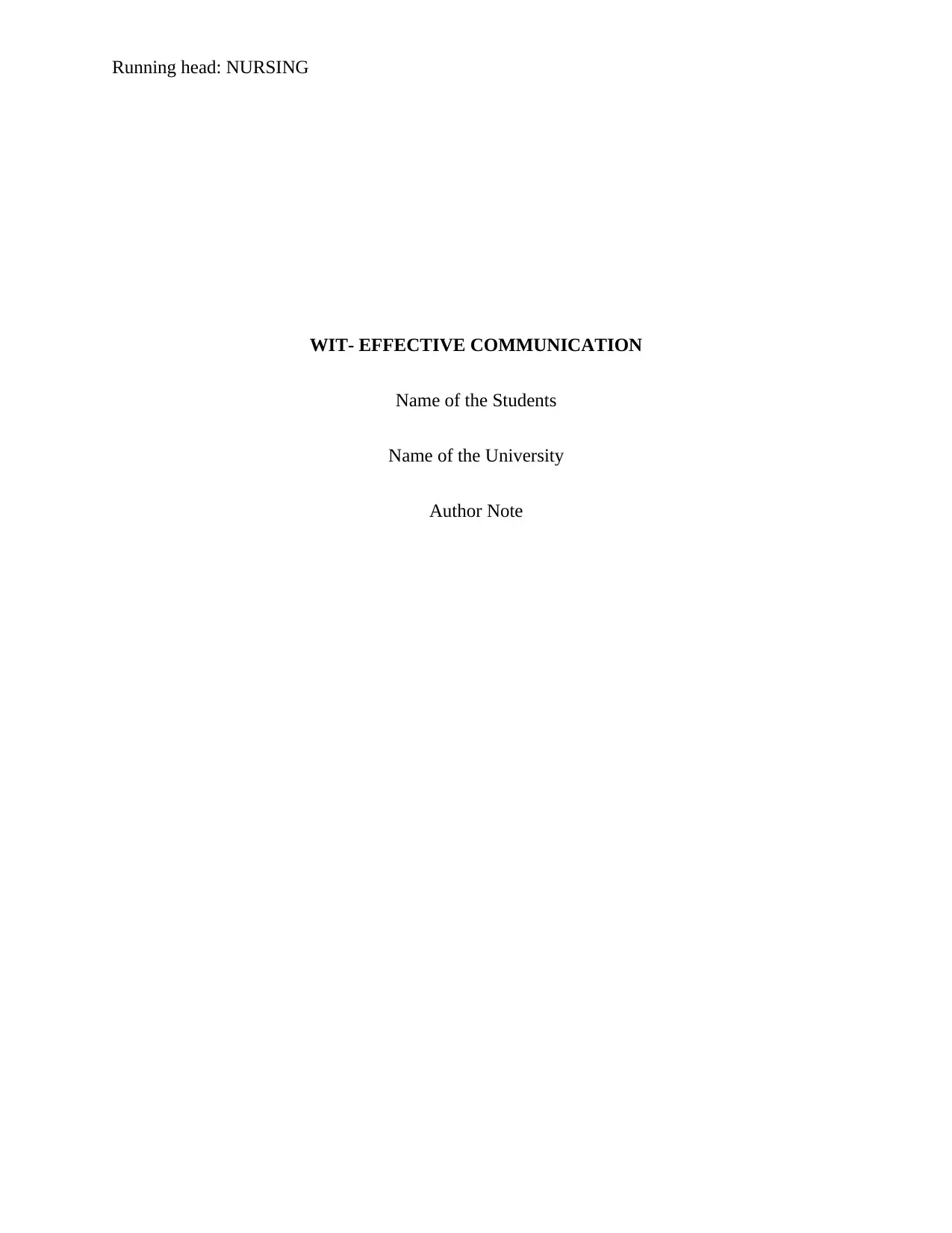
Running head: NURSING
WIT- EFFECTIVE COMMUNICATION
Name of the Students
Name of the University
Author Note
WIT- EFFECTIVE COMMUNICATION
Name of the Students
Name of the University
Author Note
Paraphrase This Document
Need a fresh take? Get an instant paraphrase of this document with our AI Paraphraser

1NURSING
Table of Contents
Part 1................................................................................................................................................3
Part 2- Reflection.............................................................................................................................5
References........................................................................................................................................7
Table of Contents
Part 1................................................................................................................................................3
Part 2- Reflection.............................................................................................................................5
References........................................................................................................................................7
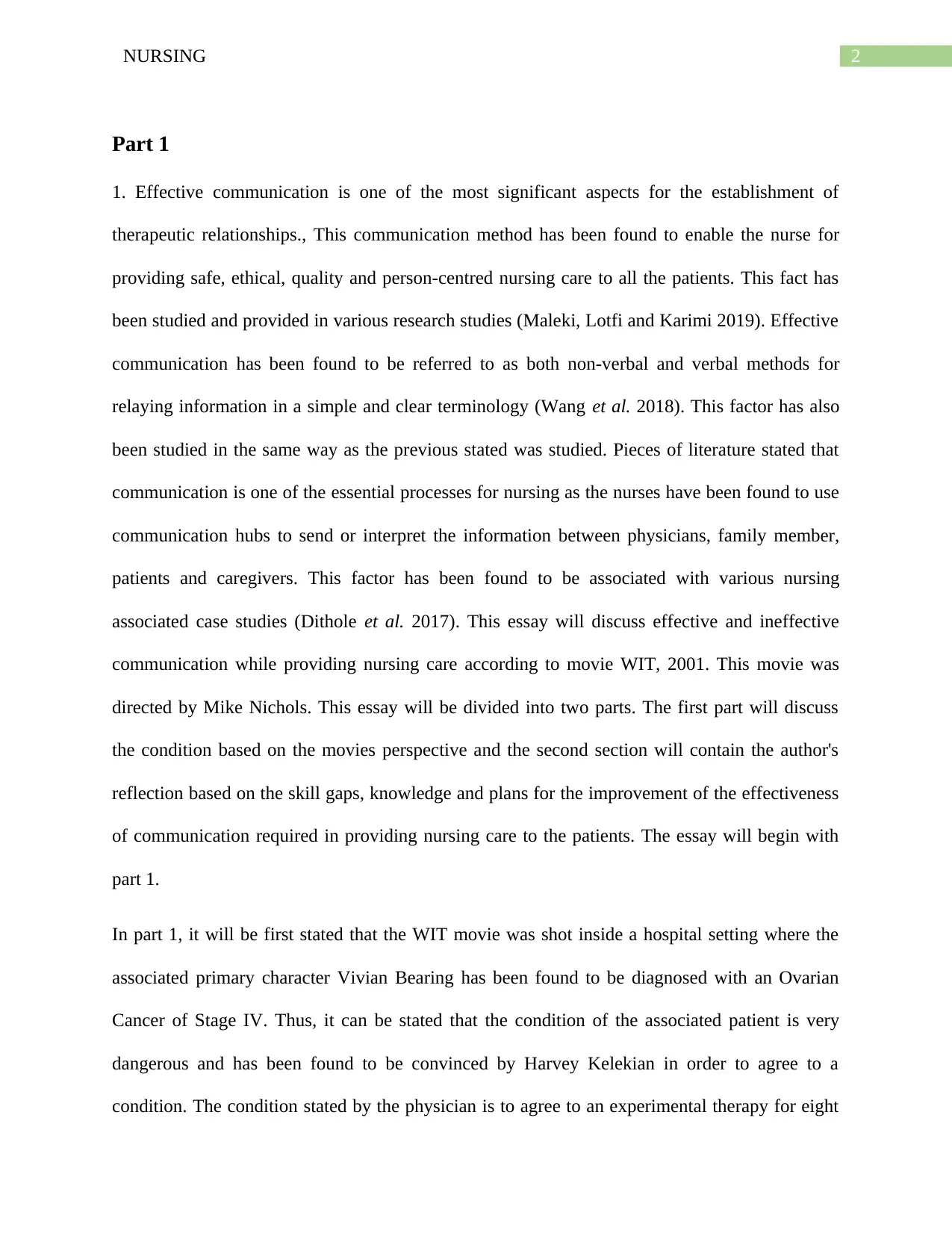
2NURSING
Part 1
1. Effective communication is one of the most significant aspects for the establishment of
therapeutic relationships., This communication method has been found to enable the nurse for
providing safe, ethical, quality and person-centred nursing care to all the patients. This fact has
been studied and provided in various research studies (Maleki, Lotfi and Karimi 2019). Effective
communication has been found to be referred to as both non-verbal and verbal methods for
relaying information in a simple and clear terminology (Wang et al. 2018). This factor has also
been studied in the same way as the previous stated was studied. Pieces of literature stated that
communication is one of the essential processes for nursing as the nurses have been found to use
communication hubs to send or interpret the information between physicians, family member,
patients and caregivers. This factor has been found to be associated with various nursing
associated case studies (Dithole et al. 2017). This essay will discuss effective and ineffective
communication while providing nursing care according to movie WIT, 2001. This movie was
directed by Mike Nichols. This essay will be divided into two parts. The first part will discuss
the condition based on the movies perspective and the second section will contain the author's
reflection based on the skill gaps, knowledge and plans for the improvement of the effectiveness
of communication required in providing nursing care to the patients. The essay will begin with
part 1.
In part 1, it will be first stated that the WIT movie was shot inside a hospital setting where the
associated primary character Vivian Bearing has been found to be diagnosed with an Ovarian
Cancer of Stage IV. Thus, it can be stated that the condition of the associated patient is very
dangerous and has been found to be convinced by Harvey Kelekian in order to agree to a
condition. The condition stated by the physician is to agree to an experimental therapy for eight
Part 1
1. Effective communication is one of the most significant aspects for the establishment of
therapeutic relationships., This communication method has been found to enable the nurse for
providing safe, ethical, quality and person-centred nursing care to all the patients. This fact has
been studied and provided in various research studies (Maleki, Lotfi and Karimi 2019). Effective
communication has been found to be referred to as both non-verbal and verbal methods for
relaying information in a simple and clear terminology (Wang et al. 2018). This factor has also
been studied in the same way as the previous stated was studied. Pieces of literature stated that
communication is one of the essential processes for nursing as the nurses have been found to use
communication hubs to send or interpret the information between physicians, family member,
patients and caregivers. This factor has been found to be associated with various nursing
associated case studies (Dithole et al. 2017). This essay will discuss effective and ineffective
communication while providing nursing care according to movie WIT, 2001. This movie was
directed by Mike Nichols. This essay will be divided into two parts. The first part will discuss
the condition based on the movies perspective and the second section will contain the author's
reflection based on the skill gaps, knowledge and plans for the improvement of the effectiveness
of communication required in providing nursing care to the patients. The essay will begin with
part 1.
In part 1, it will be first stated that the WIT movie was shot inside a hospital setting where the
associated primary character Vivian Bearing has been found to be diagnosed with an Ovarian
Cancer of Stage IV. Thus, it can be stated that the condition of the associated patient is very
dangerous and has been found to be convinced by Harvey Kelekian in order to agree to a
condition. The condition stated by the physician is to agree to an experimental therapy for eight
⊘ This is a preview!⊘
Do you want full access?
Subscribe today to unlock all pages.

Trusted by 1+ million students worldwide
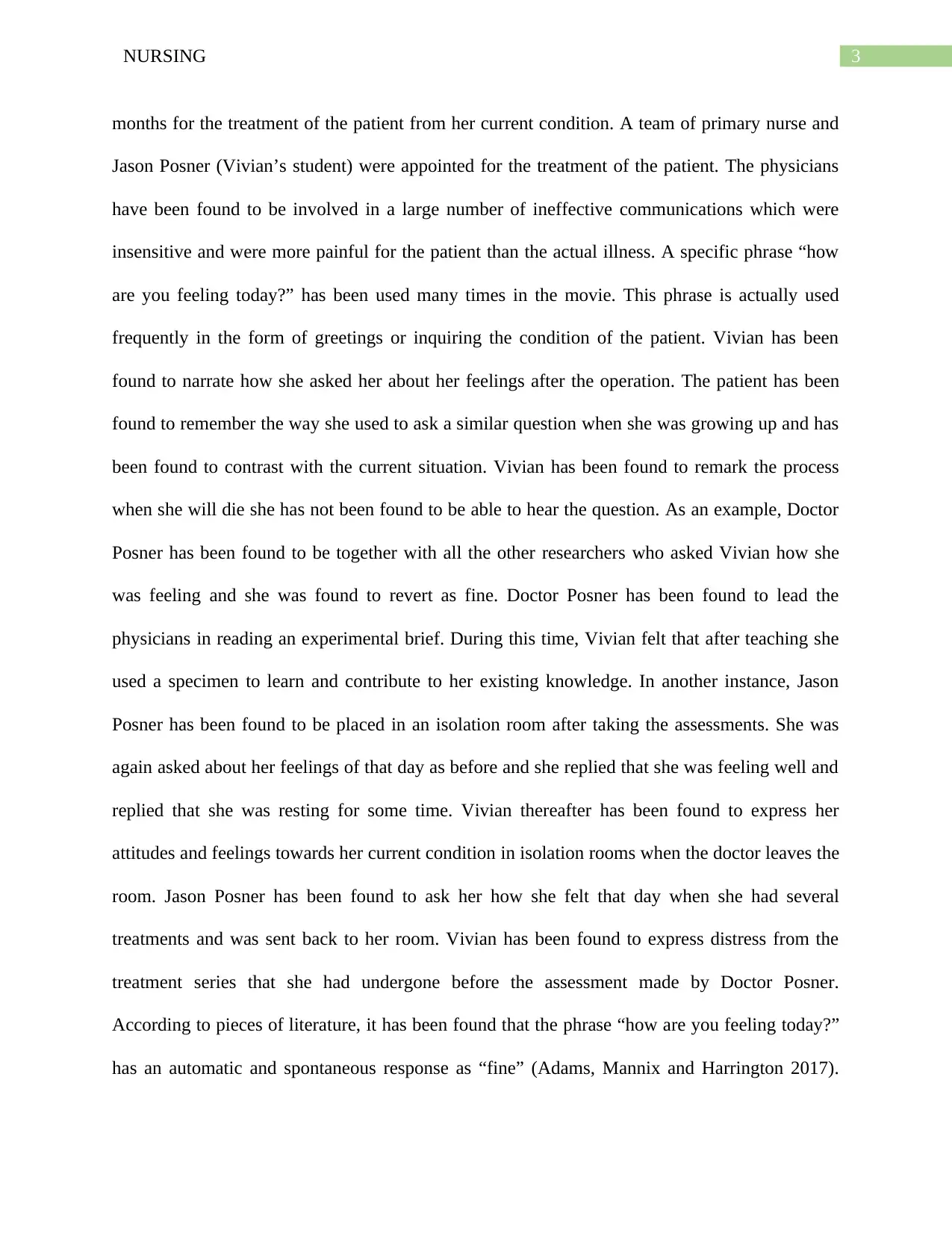
3NURSING
months for the treatment of the patient from her current condition. A team of primary nurse and
Jason Posner (Vivian’s student) were appointed for the treatment of the patient. The physicians
have been found to be involved in a large number of ineffective communications which were
insensitive and were more painful for the patient than the actual illness. A specific phrase “how
are you feeling today?” has been used many times in the movie. This phrase is actually used
frequently in the form of greetings or inquiring the condition of the patient. Vivian has been
found to narrate how she asked her about her feelings after the operation. The patient has been
found to remember the way she used to ask a similar question when she was growing up and has
been found to contrast with the current situation. Vivian has been found to remark the process
when she will die she has not been found to be able to hear the question. As an example, Doctor
Posner has been found to be together with all the other researchers who asked Vivian how she
was feeling and she was found to revert as fine. Doctor Posner has been found to lead the
physicians in reading an experimental brief. During this time, Vivian felt that after teaching she
used a specimen to learn and contribute to her existing knowledge. In another instance, Jason
Posner has been found to be placed in an isolation room after taking the assessments. She was
again asked about her feelings of that day as before and she replied that she was feeling well and
replied that she was resting for some time. Vivian thereafter has been found to express her
attitudes and feelings towards her current condition in isolation rooms when the doctor leaves the
room. Jason Posner has been found to ask her how she felt that day when she had several
treatments and was sent back to her room. Vivian has been found to express distress from the
treatment series that she had undergone before the assessment made by Doctor Posner.
According to pieces of literature, it has been found that the phrase “how are you feeling today?”
has an automatic and spontaneous response as “fine” (Adams, Mannix and Harrington 2017).
months for the treatment of the patient from her current condition. A team of primary nurse and
Jason Posner (Vivian’s student) were appointed for the treatment of the patient. The physicians
have been found to be involved in a large number of ineffective communications which were
insensitive and were more painful for the patient than the actual illness. A specific phrase “how
are you feeling today?” has been used many times in the movie. This phrase is actually used
frequently in the form of greetings or inquiring the condition of the patient. Vivian has been
found to narrate how she asked her about her feelings after the operation. The patient has been
found to remember the way she used to ask a similar question when she was growing up and has
been found to contrast with the current situation. Vivian has been found to remark the process
when she will die she has not been found to be able to hear the question. As an example, Doctor
Posner has been found to be together with all the other researchers who asked Vivian how she
was feeling and she was found to revert as fine. Doctor Posner has been found to lead the
physicians in reading an experimental brief. During this time, Vivian felt that after teaching she
used a specimen to learn and contribute to her existing knowledge. In another instance, Jason
Posner has been found to be placed in an isolation room after taking the assessments. She was
again asked about her feelings of that day as before and she replied that she was feeling well and
replied that she was resting for some time. Vivian thereafter has been found to express her
attitudes and feelings towards her current condition in isolation rooms when the doctor leaves the
room. Jason Posner has been found to ask her how she felt that day when she had several
treatments and was sent back to her room. Vivian has been found to express distress from the
treatment series that she had undergone before the assessment made by Doctor Posner.
According to pieces of literature, it has been found that the phrase “how are you feeling today?”
has an automatic and spontaneous response as “fine” (Adams, Mannix and Harrington 2017).
Paraphrase This Document
Need a fresh take? Get an instant paraphrase of this document with our AI Paraphraser
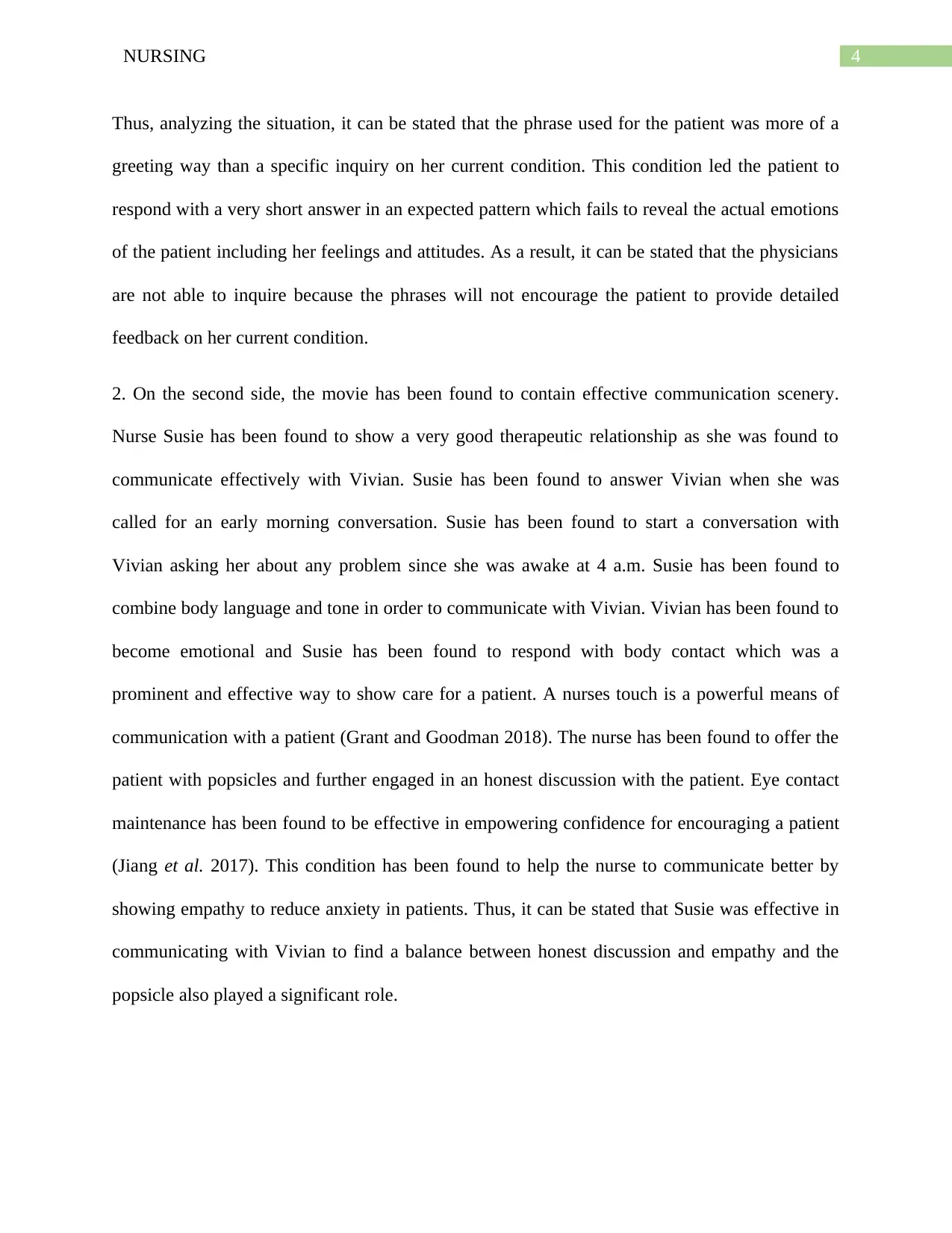
4NURSING
Thus, analyzing the situation, it can be stated that the phrase used for the patient was more of a
greeting way than a specific inquiry on her current condition. This condition led the patient to
respond with a very short answer in an expected pattern which fails to reveal the actual emotions
of the patient including her feelings and attitudes. As a result, it can be stated that the physicians
are not able to inquire because the phrases will not encourage the patient to provide detailed
feedback on her current condition.
2. On the second side, the movie has been found to contain effective communication scenery.
Nurse Susie has been found to show a very good therapeutic relationship as she was found to
communicate effectively with Vivian. Susie has been found to answer Vivian when she was
called for an early morning conversation. Susie has been found to start a conversation with
Vivian asking her about any problem since she was awake at 4 a.m. Susie has been found to
combine body language and tone in order to communicate with Vivian. Vivian has been found to
become emotional and Susie has been found to respond with body contact which was a
prominent and effective way to show care for a patient. A nurses touch is a powerful means of
communication with a patient (Grant and Goodman 2018). The nurse has been found to offer the
patient with popsicles and further engaged in an honest discussion with the patient. Eye contact
maintenance has been found to be effective in empowering confidence for encouraging a patient
(Jiang et al. 2017). This condition has been found to help the nurse to communicate better by
showing empathy to reduce anxiety in patients. Thus, it can be stated that Susie was effective in
communicating with Vivian to find a balance between honest discussion and empathy and the
popsicle also played a significant role.
Thus, analyzing the situation, it can be stated that the phrase used for the patient was more of a
greeting way than a specific inquiry on her current condition. This condition led the patient to
respond with a very short answer in an expected pattern which fails to reveal the actual emotions
of the patient including her feelings and attitudes. As a result, it can be stated that the physicians
are not able to inquire because the phrases will not encourage the patient to provide detailed
feedback on her current condition.
2. On the second side, the movie has been found to contain effective communication scenery.
Nurse Susie has been found to show a very good therapeutic relationship as she was found to
communicate effectively with Vivian. Susie has been found to answer Vivian when she was
called for an early morning conversation. Susie has been found to start a conversation with
Vivian asking her about any problem since she was awake at 4 a.m. Susie has been found to
combine body language and tone in order to communicate with Vivian. Vivian has been found to
become emotional and Susie has been found to respond with body contact which was a
prominent and effective way to show care for a patient. A nurses touch is a powerful means of
communication with a patient (Grant and Goodman 2018). The nurse has been found to offer the
patient with popsicles and further engaged in an honest discussion with the patient. Eye contact
maintenance has been found to be effective in empowering confidence for encouraging a patient
(Jiang et al. 2017). This condition has been found to help the nurse to communicate better by
showing empathy to reduce anxiety in patients. Thus, it can be stated that Susie was effective in
communicating with Vivian to find a balance between honest discussion and empathy and the
popsicle also played a significant role.
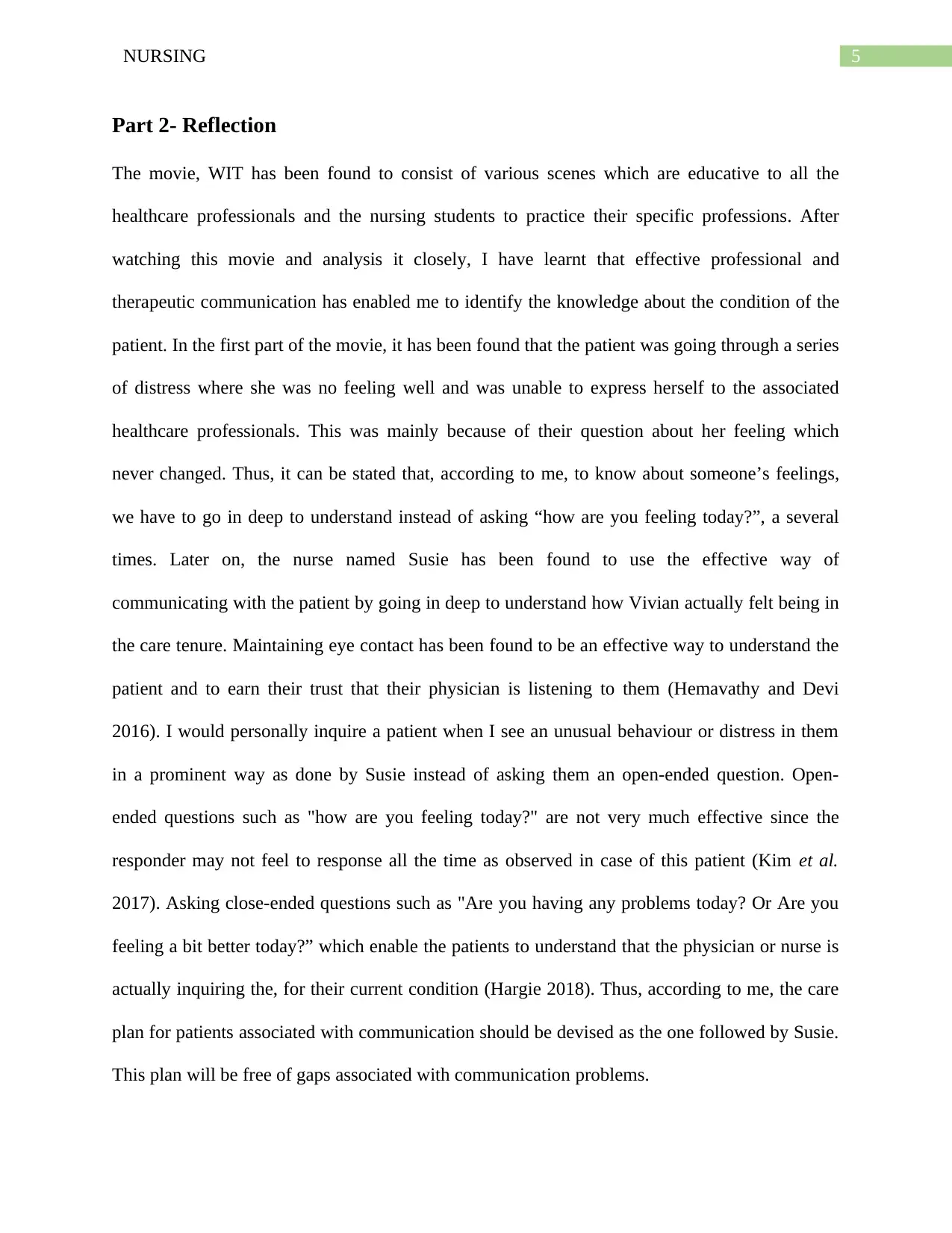
5NURSING
Part 2- Reflection
The movie, WIT has been found to consist of various scenes which are educative to all the
healthcare professionals and the nursing students to practice their specific professions. After
watching this movie and analysis it closely, I have learnt that effective professional and
therapeutic communication has enabled me to identify the knowledge about the condition of the
patient. In the first part of the movie, it has been found that the patient was going through a series
of distress where she was no feeling well and was unable to express herself to the associated
healthcare professionals. This was mainly because of their question about her feeling which
never changed. Thus, it can be stated that, according to me, to know about someone’s feelings,
we have to go in deep to understand instead of asking “how are you feeling today?”, a several
times. Later on, the nurse named Susie has been found to use the effective way of
communicating with the patient by going in deep to understand how Vivian actually felt being in
the care tenure. Maintaining eye contact has been found to be an effective way to understand the
patient and to earn their trust that their physician is listening to them (Hemavathy and Devi
2016). I would personally inquire a patient when I see an unusual behaviour or distress in them
in a prominent way as done by Susie instead of asking them an open-ended question. Open-
ended questions such as "how are you feeling today?" are not very much effective since the
responder may not feel to response all the time as observed in case of this patient (Kim et al.
2017). Asking close-ended questions such as "Are you having any problems today? Or Are you
feeling a bit better today?” which enable the patients to understand that the physician or nurse is
actually inquiring the, for their current condition (Hargie 2018). Thus, according to me, the care
plan for patients associated with communication should be devised as the one followed by Susie.
This plan will be free of gaps associated with communication problems.
Part 2- Reflection
The movie, WIT has been found to consist of various scenes which are educative to all the
healthcare professionals and the nursing students to practice their specific professions. After
watching this movie and analysis it closely, I have learnt that effective professional and
therapeutic communication has enabled me to identify the knowledge about the condition of the
patient. In the first part of the movie, it has been found that the patient was going through a series
of distress where she was no feeling well and was unable to express herself to the associated
healthcare professionals. This was mainly because of their question about her feeling which
never changed. Thus, it can be stated that, according to me, to know about someone’s feelings,
we have to go in deep to understand instead of asking “how are you feeling today?”, a several
times. Later on, the nurse named Susie has been found to use the effective way of
communicating with the patient by going in deep to understand how Vivian actually felt being in
the care tenure. Maintaining eye contact has been found to be an effective way to understand the
patient and to earn their trust that their physician is listening to them (Hemavathy and Devi
2016). I would personally inquire a patient when I see an unusual behaviour or distress in them
in a prominent way as done by Susie instead of asking them an open-ended question. Open-
ended questions such as "how are you feeling today?" are not very much effective since the
responder may not feel to response all the time as observed in case of this patient (Kim et al.
2017). Asking close-ended questions such as "Are you having any problems today? Or Are you
feeling a bit better today?” which enable the patients to understand that the physician or nurse is
actually inquiring the, for their current condition (Hargie 2018). Thus, according to me, the care
plan for patients associated with communication should be devised as the one followed by Susie.
This plan will be free of gaps associated with communication problems.
⊘ This is a preview!⊘
Do you want full access?
Subscribe today to unlock all pages.

Trusted by 1+ million students worldwide
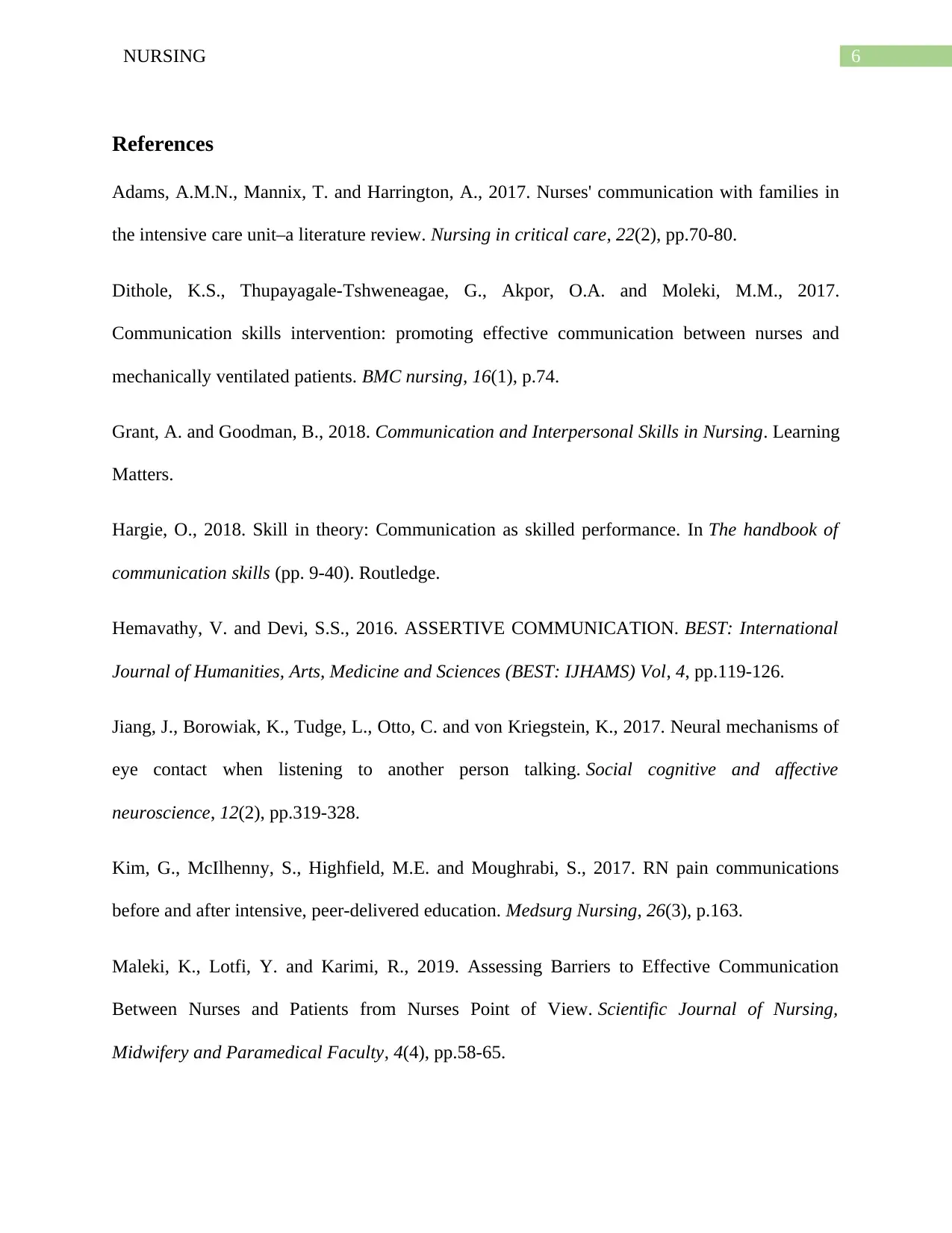
6NURSING
References
Adams, A.M.N., Mannix, T. and Harrington, A., 2017. Nurses' communication with families in
the intensive care unit–a literature review. Nursing in critical care, 22(2), pp.70-80.
Dithole, K.S., Thupayagale-Tshweneagae, G., Akpor, O.A. and Moleki, M.M., 2017.
Communication skills intervention: promoting effective communication between nurses and
mechanically ventilated patients. BMC nursing, 16(1), p.74.
Grant, A. and Goodman, B., 2018. Communication and Interpersonal Skills in Nursing. Learning
Matters.
Hargie, O., 2018. Skill in theory: Communication as skilled performance. In The handbook of
communication skills (pp. 9-40). Routledge.
Hemavathy, V. and Devi, S.S., 2016. ASSERTIVE COMMUNICATION. BEST: International
Journal of Humanities, Arts, Medicine and Sciences (BEST: IJHAMS) Vol, 4, pp.119-126.
Jiang, J., Borowiak, K., Tudge, L., Otto, C. and von Kriegstein, K., 2017. Neural mechanisms of
eye contact when listening to another person talking. Social cognitive and affective
neuroscience, 12(2), pp.319-328.
Kim, G., McIlhenny, S., Highfield, M.E. and Moughrabi, S., 2017. RN pain communications
before and after intensive, peer-delivered education. Medsurg Nursing, 26(3), p.163.
Maleki, K., Lotfi, Y. and Karimi, R., 2019. Assessing Barriers to Effective Communication
Between Nurses and Patients from Nurses Point of View. Scientific Journal of Nursing,
Midwifery and Paramedical Faculty, 4(4), pp.58-65.
References
Adams, A.M.N., Mannix, T. and Harrington, A., 2017. Nurses' communication with families in
the intensive care unit–a literature review. Nursing in critical care, 22(2), pp.70-80.
Dithole, K.S., Thupayagale-Tshweneagae, G., Akpor, O.A. and Moleki, M.M., 2017.
Communication skills intervention: promoting effective communication between nurses and
mechanically ventilated patients. BMC nursing, 16(1), p.74.
Grant, A. and Goodman, B., 2018. Communication and Interpersonal Skills in Nursing. Learning
Matters.
Hargie, O., 2018. Skill in theory: Communication as skilled performance. In The handbook of
communication skills (pp. 9-40). Routledge.
Hemavathy, V. and Devi, S.S., 2016. ASSERTIVE COMMUNICATION. BEST: International
Journal of Humanities, Arts, Medicine and Sciences (BEST: IJHAMS) Vol, 4, pp.119-126.
Jiang, J., Borowiak, K., Tudge, L., Otto, C. and von Kriegstein, K., 2017. Neural mechanisms of
eye contact when listening to another person talking. Social cognitive and affective
neuroscience, 12(2), pp.319-328.
Kim, G., McIlhenny, S., Highfield, M.E. and Moughrabi, S., 2017. RN pain communications
before and after intensive, peer-delivered education. Medsurg Nursing, 26(3), p.163.
Maleki, K., Lotfi, Y. and Karimi, R., 2019. Assessing Barriers to Effective Communication
Between Nurses and Patients from Nurses Point of View. Scientific Journal of Nursing,
Midwifery and Paramedical Faculty, 4(4), pp.58-65.
Paraphrase This Document
Need a fresh take? Get an instant paraphrase of this document with our AI Paraphraser
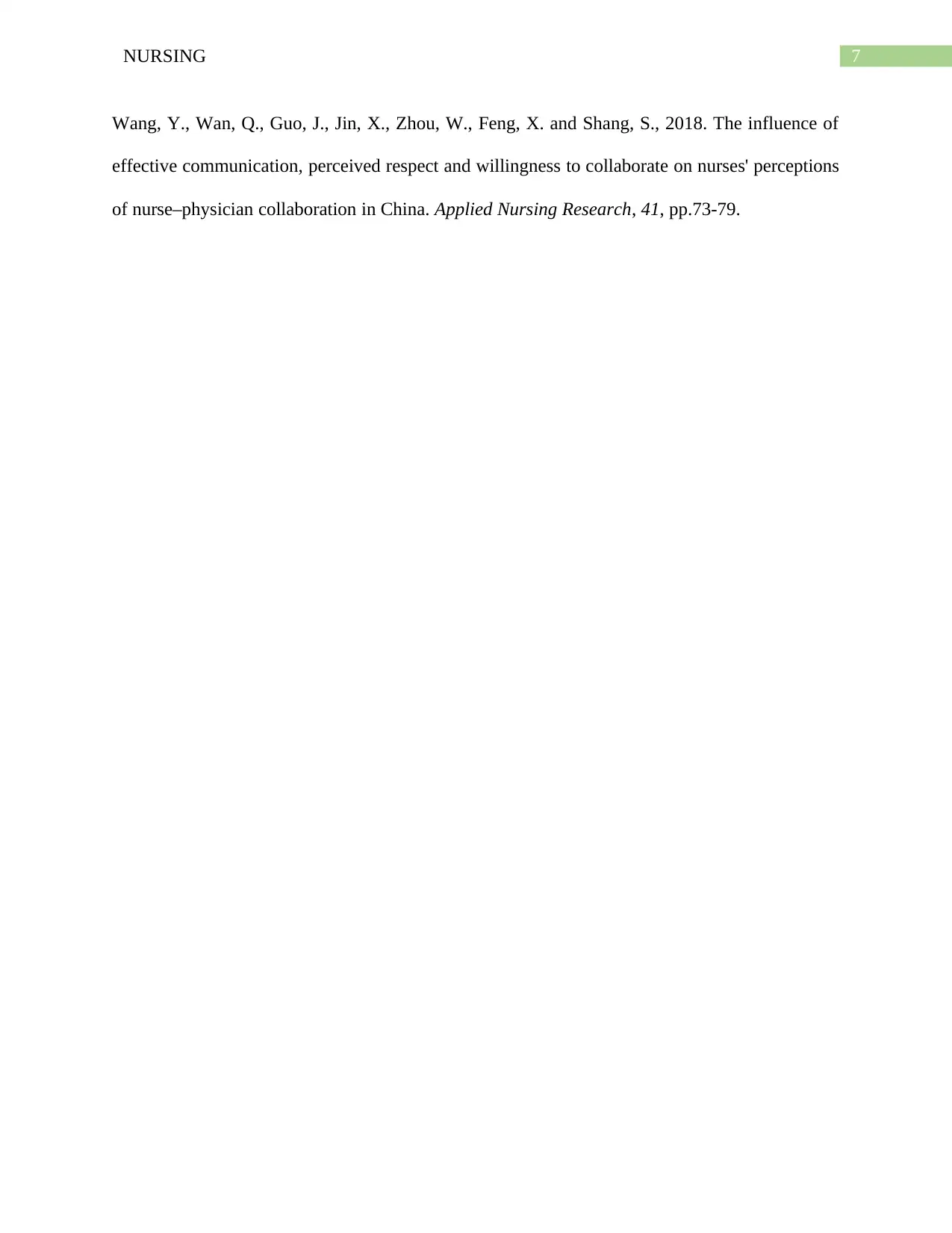
7NURSING
Wang, Y., Wan, Q., Guo, J., Jin, X., Zhou, W., Feng, X. and Shang, S., 2018. The influence of
effective communication, perceived respect and willingness to collaborate on nurses' perceptions
of nurse–physician collaboration in China. Applied Nursing Research, 41, pp.73-79.
Wang, Y., Wan, Q., Guo, J., Jin, X., Zhou, W., Feng, X. and Shang, S., 2018. The influence of
effective communication, perceived respect and willingness to collaborate on nurses' perceptions
of nurse–physician collaboration in China. Applied Nursing Research, 41, pp.73-79.
1 out of 8
Related Documents
Your All-in-One AI-Powered Toolkit for Academic Success.
+13062052269
info@desklib.com
Available 24*7 on WhatsApp / Email
![[object Object]](/_next/static/media/star-bottom.7253800d.svg)
Unlock your academic potential
Copyright © 2020–2025 A2Z Services. All Rights Reserved. Developed and managed by ZUCOL.





